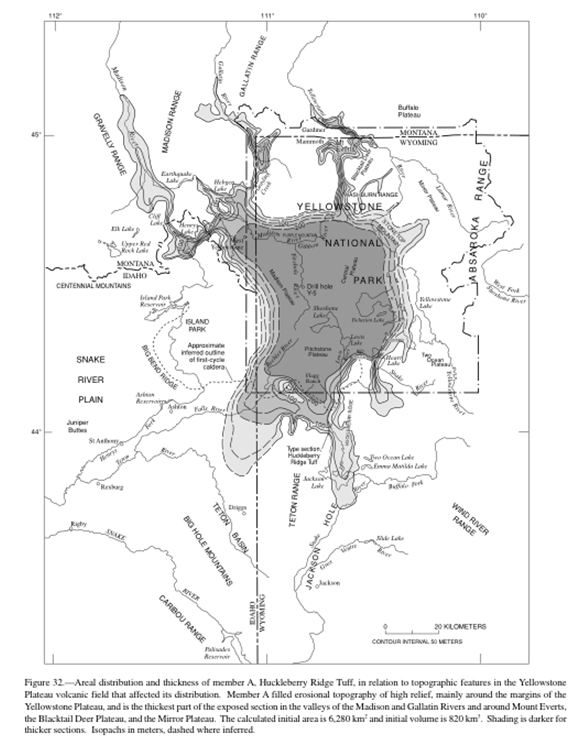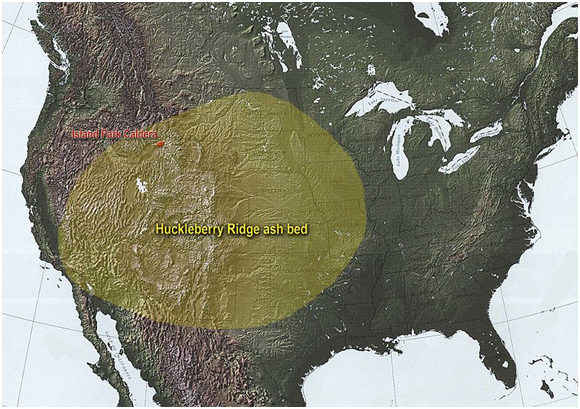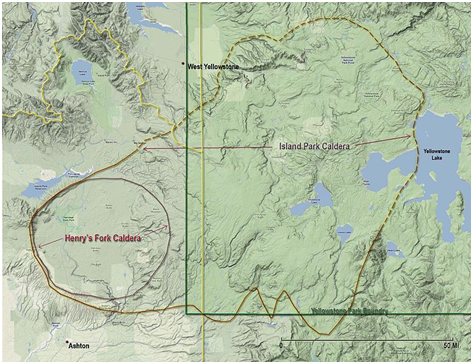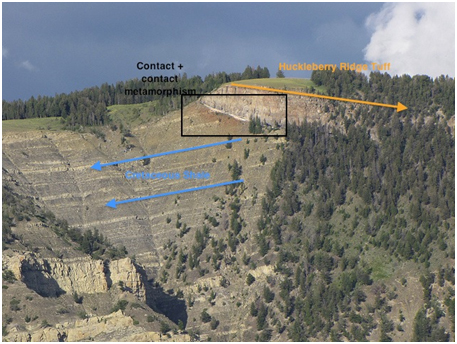This is the third of several guest posts that will appear here this week, all written by students who participated in this past summer’s Regional Field Geology of the Northern Rocky Mountains course.
by Matthew Mann
University of Virginia
The Huckleberry Ridge Tuff is a 2.1 Ma tuff deposit that is centrally located in Yellowstone (Figure 1), but can be found throughout much of the United States (Figure 2). The tuff was deposited as a result of the eruption that formed the Island Park Caldera (Figure 3, Wikipedia). This blog post will look at three locations of the Huckleberry Ridge Tuff seen on the trip: The Golden Gate Canyon in Yellowstone, Mt. Everets, and a location in the Madison River Valley, near Earthquake Lake and Hebgen Lake. Unless otherwise stated, all observations are my own or are a result of lectures that were given by the professors on the course.
The first outcrop to be analyzed will be the Golden Gate Canyon outcrop. This outcrop was visited on July 3rd, 2013. This outcrop was a road cut in the Golden Gate Canyon, and due to safety concerns rock samples were brought from the outcrop to a safe area to examine. These samples were a weathered yellow color. The sample was a rhyolitic tuff, with many lithic fragments present in it (20%). The lithic fragments were predominately quartz and feldspars. The fragments were roughly .5 to 1 cm large. The tuff’s groundmass was composed of glass. I would consider this rock to be a tuff vitrophyre.
The second outcrop was the top of Mt. Everts (Figure 4). This outcrop was not actually visited, but instead observed from the Grand Loop Road in Yellowstone on two occasions: the morning of July 3rd from the base of Mt. Everts, and the afternoon of the 3rd from a lookout on the Grand Loop Road. This outcrop, as shown in Figure 4, has 3 distinct areas. The strata on the left are Cretaceous sediments, predominately shales, and are dipping towards the West-northwest. The strata on the right are the Huckleberry Ridge Tuff, and are dipping toward the East-Southeast. The third area is the contact between the two strata. First, this contact is an angular unconformity, with further tilting done after the tuff was deposited. Secondly, below the tuff/Cretaceous contact, there is a layer of red colored sediments.
Figure 1: The distribution of the A member of the Huckleberry Ridge Tuff. This distribution was chosen because it is the lower member of the Huckleberry Ridge Tuff, and based on the contact on Mt. Everts, I believe that this distribution is likely the most accurate for the outcrops I have seen (Christiansen, 2001):

Figure 2: The spatial extent of the Huckleberry Ridge Tuff ash bed (Wikipedia):

Figure 3: Spatial extent of the Island Park Caldera, the caldera that formed after the volcanic eruption 2.1 Ma (Wikipedia):

This red area is evidence of contact metamorphism from the Huckleberry Ridge Tuff. The tuff was either already warm enough to metamorphose the sediments below it, or as later ash was deposited on it, it grew to a warm enough temperature to slightly metamorphose the sediments below it.
The third outcrop was located in the Madison River Valley, on a forest service road off of Route 287, about 15 minutes north of Hebgen Lake and Earthquake Lake. This outcrop was visited on July 7th. The outcrop was about 20-30 feet high. This outcrop was composed of the Huckleberry Ridge Tuff, but with many different facies exposed. There were at least three facies present in the outcrop: a vitrophyre, a banded tuff, and a tuff vitrophyre. The vitrophyre had a medium grey weathered surface, with a dark grey fresh surface, and was composed nearly entirely of glass, with few (<10%) lithic fragments in it. The glass was welded together, suggesting either burial or low temperature metamorphism. The second type of rock found at this outcrop was a finely banded tuff (Figure 5). This rock is composed of 40% light colored glassy material and 60% dark colored glassy material. The rock itself weighs little, as it is not dense. The third rock facies is a tuff vitrophyre. This rock is slightly off white, with a groundmass of glass. There are lithic fragments (<10%) in the rock, of fine dark material, possibly biotite. Petrographic studies are needed to truly determine the mineral composition in this rock. Overall, the outcrop is a tuffaceous volcanoclastic unit with varying colors, compositions and amount of lithics. The outcrop does not show significant welding, and bedding is more or less (5% or less from horizontal) horizontal. There are also examples of graded bedding in the outcrop, with grading going coarser to finer as you move stratigraphically up.
Figure 4: Contact between Cretaceous shales and Huckleberry Ridge Tuff. Not the black box: This is the contact, and the red sediments below the contact are resultant of contact metamorphism (Photo credit: touristlink.com):

Figure 5: Banded tuff from the Huckleberry Ridge Tuff. Note the very fine bands and lack of lithic fragments:

Much research has been done on the geology of Yellowstone National Park, and for the Huckleberry Ridge Tuff Robert Christiansen’s “The Quaternary and Pliocene Yellowstone Plateau Volcanic Field of Wyoming, Idaho, and Montana” professional paper is incredibly useful for understanding recent volcanic events in the Yellowstone area (Christiansen, 2001). In his paper, he postulates that the Huckleberry Ridge tuff has a basal ash fall layer, with 3 members of ash flow layers that are stratigraphically above the basal ash fall layer. Christiansen is careful not to use the term pyroclastic flow when describing the Huckleberry Ridge Tuff. My understanding of the Huckleberry Ridge tuff, based on my personal observations, lectures during the class and Christiansians paper, is that there was one main eruption that deposited the Huckleberry Ridge Tuff, but there were multiple pulses of this eruption. Evidence for this is the different facies in the Huckleberry Ridge Tuff. As different pulses occurred, different parts of the magma chamber were blown out, creating the lithological differences in the formation. In two of the outcrops, the Mt. Everts and the Madison River Valley outcrops, the tuff appears to be deposited through ash falls instead of ash flows. As Professor Callan said in class, ash flows tend to be hotter, and as such welded. Neither of these outcrops appeared to be welded, although the Mt. Everts did have contact metamorphism with the lower units where it was deposited. This contact metamorphism did not appear to be too intense, though, as there appears to be a very small zone of metamorphism. The third outcrop, the Golden Gate Canyon outcrop, Christiansen describes as an ash flow. Based on the outcrop and rock samples, I saw no evidence of a pyroclastic flow: no large lithic fragments and no intense welding of the tuff. In “Windows into the Earth: The Geologic Story of Yellowstone and Grand Teton National Parks”, the authors, Smith and Siegel, suggest that the ash deposits flowed in large clouds some considerable distances (2000). If this is what Christiansen means when he uses the term “ash flow”, than it could be conceivable that the outcrop at Golden Gate Canyon could have been formed by a hot, dense cloud of ash that to an extent could have “flowed” into a topographically low area.
In the unit, the probable age relations are as follows: since the Mt. Everts is resting uncomfortably on eroded Cretaceous sediments, and the ash was deposited through ash fall, I believe that this is the oldest outcrop of the three. The middle-aged outcrop would be the Golden Gate Canyon outcrop, as that outcrop is relatively close to the Mt. Everts outcrop. The oldest would be the Madison River Valley outcrop, as it is located the furthest out from the other two outcrops. However, without careful geologic mapping and possibly isotope dating, it would be difficult to accurately date any of these units, as three outcrop exposures are not really enough to allow me to confidently make relative date for the outcrops.
Since the eruption 2.1 Ma that produced the Huckleberry Ridge Tuff, there have been two other major eruptions of the Yellowstone Hotspot, one at 1.3 Ma (Mesa Falls Tuff) and one at 0.64 Ma (Lava Creek Tuff) (Christiansen, 2001). These eruptions also deposited large tuff deposits in the Yellowstone area, along with the creation of other calderas. Christiansen also notes many other smaller eruptions that have occurred in the Yellowstone area, along with their associated lava flows. There has also been extensive hydrothermal alteration in the Yellowstone area, as seen today in Mammoth and other hydrothermally active areas. Finally, during the Pleistocene, numerous ice sheets moved through the area, carving the landscape, with the final period of glaciation creating the landscape currently seen in Yellowstone. These events have effectively covered up the Huckleberry Ridge Tuff, creating a situation where the only places that I saw the outcrop on the trip were on ridges, a sentiment that Christiansen also shared.
Works Cited
“Huckleberry Ridge Tuff.” United States Tourist Information. Touristlink.com, n.d. Web. 11 Aug. 2013. <http://www.touristlink.com/united-states/huckleberry-ridge-tuff-yellowstone/overview.html>.
Metrodyne. “File:HuckleberryRidgeTuff.jpg.” Wikipedia.org. Wikipedia, 14 Dec. 2008. Web. 11 Aug. 2013. <http://en.wikipedia.org/wiki/File:HuckleberryRidgeTuff.jpg>.
Metrodyne. “File:IPCaldera.jpg.” Wikipedia.org. Wikipedia, 11 Dec. 2008. Web. 11 Aug. 2013. <http://en.wikipedia.org/wiki/File:IPCaldera.jpg>.
Smith, Robert B., and Lee J. Siegel. Windows into the Earth: The Geologic Story of Yellowstone and Grand Teton National Parks. New York: Oxford UP, 2000. Print.
United States. USGS. The Quaternary and Pliocene Yellowstone Plateau Volcanic Field of Wyoming, Idaho, and Montana. By Robert L. Christiansen. Vol. 729-g. Reston: USGS, 2001. Print.

The Huckleberry Ridge might not be quite so super, based on some recent work:
http://www.sciencedirect.com/science/article/pii/S1871101412000088